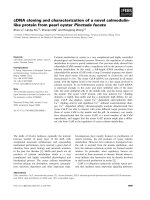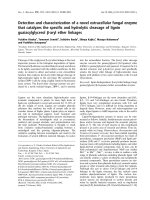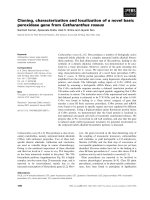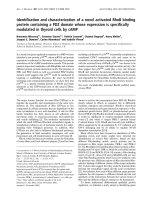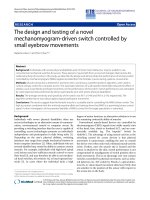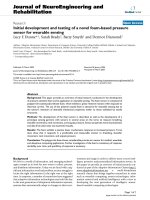Identifcation and stablization of a novel 3d hepatocyte monolayer for hepatocyte based applications
Bạn đang xem bản rút gọn của tài liệu. Xem và tải ngay bản đầy đủ của tài liệu tại đây (7.26 MB, 167 trang )
IDENTIFICATION AND STABILIZATION OF A NOVEL
3D HEPATOCYTE MONOLAYER FOR HEPATOCYTE-
BASED APPLICATIONS
DU YANAN
(B.Eng., Tsinghua Univ, China)
A THESIS SUBMITTED
FOR THE DEGREE OF DOCTOR OF PHILOSOPHY
NUS GRADUATE SCHOOL FOR INTEGRATIVE
SCIENCES & ENGINEERING
NATIONAL UNIVERSITY OF SINGAPORE
2007
- I -
ACKNOWLEDGEMENTS
First of all, I would like to thank my advisor, Prof. Hanry Yu, for his guidance,
inspiration and support during my PhD training in his lab. I have been very lucky to
enjoy the great mentorship, terrific research environment and many invaluable
opportunities provided by him, without which my progress and the completion of the
thesis are impossible. His passion for science, dauntlessness for breaking the barrier of
different research paradigms and dedication to nurture the scientific growth of students
has influenced me a lot and will continue to inspire me in my pursuit of future career. I
would also like to extend my sincere gratitude to my co-supervisor, Prof. Thorsten
Wohland, for the stimulating scientific discussions and his guidance on our collaborated
project, my PhD QE proposal as well as all the manuscripts of my published papers. All
these have been a great experience for me.
Next, I would like to thank the people with whom I have spent most of the time
during my PhD study, my colleagues in the Cell and Tissue Engineering Lab at the
Institute of Bioengineering and Nanotechnology (IBN) and NUS. I thank all group
members in the Bioartificial Liver project for the teamwork we have had together,
especially to Mr. Han Rongbin for being such a wonderful collaborator. My project
cannot move forward so smoothly without the great help and intelligent stimulations from
him. The days and nights when we worked together were really unforgettable. I thank the
senior researchers in the lab, Drs. Chia Ser-Mien, Leo Hua Liang, Norbert Weber, Sun
Wanxin, Mr. Wen Feng, Talha Arooz, Wu Yingnan and Mrs. Jing Zhang, Susanne Ng,
Toh Yi Chin, Khong Yuet Mei, who have always been kind and helpful when I met
problems. I am also grateful to Mr. Chang Shi, Wang Xianwei, Ms Kuan Foong-Yee, and
- II -
Mrs. Zhou Sibo and Kelly Marie Doss for their great supports. Other people outside lab,
to whom I would like to extend my gratitude, include Profs. Teoh Sween Hin, Tan Choon
Hong, Caroline Lee, SHEU Fwu-Shan, FENG Si-Shen from NUS for their guidance
during my lab rotation and PhD qualification exam; Dr. Dan Yock Young from NUH for
the collaborated project on fetal liver cells; Ms Meng Qingying from IBN on her help of
Western blot. I would also like to acknowledge the financial support from the IBN,
Biomedical Research Council, Agency for Science, Technology and Research (A*STAR);
as well as my scholarship and Graduate President Fellowship rewarded by Ministry of
Education and NUS.
Last but not least, I would like to thank my parents and friends for their unconditional
supports and love to help me get through thick and thin.
- III -
TABLE OF CONTENTS
ACKNOWLEDGEMENT……………………………………………………… I
TABLE OF CONTENTS………………………………………………………………….III
SUMMARY…………………………………………………………………………………V
LIST OF PUBLICATIONS…………………………………………………………… VIII
LIST OF FIGURES AND TABLES…………………………………………………… IX
LIST OF SYMBOLS…………………………………………………………………….XIII
Chapter 1 Introductions………………………………………………………………….1
1.1 Hepatocyte-based applications in liver tissue engineering 3
1.1.1 Liver physiology and functions 3
1.1.2 Overview of liver tissue engineering 5
1.1.3 Hepatocyte-based drug metabolism/hepatotoxicity screening 7
1.1.4 Hepatocyte-based bioartificial liver assisted devices (BLAD) 11
1.2 In vitro hepatocyte culture models in hepatocyte-based applications 14
1.1.3 Overview of various approaches for hepatocyte functional maintenance in
vitro 14
1.2.1 2D hepatocyte culture model 17
1.2.2 Sandwich hepatocyte culture model 19
1.2.3 3D hepatocyte spheroid culture model 20
1.3 Natural and synthetic biomaterials for hepatocyte culture 21
1.3.1 Overview of the natural and synthetic biomaterials for hepatocyte culture
22
1.3.2 RGD-modified biomaterials for hepatocyte culture 24
1.3.3 Galactosylated biomaterials for hepatocyte culture 25
1.3.4 Current understandings of the morphogenesis mechanisms governing the
cell adhesion and spheroid formation 27
1.4 Problems with the current hepatocyte in vitro culture model for hepatocyte-
based applications 29
1.5 Objectives and significance of the current study 30
1.6 References for chapter 1 32
Chapter 2 Fabrication and characterization of Galactosylated, GRGDS-modified and
Hybrid GRGDS/Galactose modified polyethylene terephthalate film………41
2.1 Introduction 42
2.2 Materials and methods 43
2.3 Results 49
- IV -
2.3.1 Fabrication and characterization of PET film grafted with poly-acrylic
acid 49
2.3.2 Fabrication and characterization of bioactive substrata 51
2.3.3 Enhancement of hepatocyte attachment on the bioactive substrata 52
2.4 Conclusion and discussion 54
2.5 References for chapter 2 55
Chapter 3 Identification and characterization of a 3D hepatocyte monolayer on a
galatosylated polyethylene terephthalate film……………………………… 57
3.1 Introduction 58
3.2 Materials and methods 60
3.3 Results 66
3.4 Conclusion and discussion 79
3.5 References for chapter 3 82
Chapter 4 Short-term stabilization of the 3D hepatocyte monolayer using Hybrid
GRGDS/Galactose PET film for xenobiotics hepatotoxicity screening…… 85
4.1 Introduction 86
4.2 Materials and methods 87
4.3 Results 91
4.4 Conclusions and discussions 103
4.5 References for chapter 4 106
Chapter 5 Longer-term stabilization of the hepatocyte 3D monolayer using a novel
synthetic sandwich…………………………………………………………….108
5.1 Introduction 109
5.2 Materials and methods 111
5.3 Results 121
5.4 Conclusion and discussion 134
5.5 References in chapter 5 138
Chapter 6 Conclusions and Directions for future investigation…………………… 141
6.1 Conclusions 142
6.2 Directions for future investigation 144
Appendix Invention disclosure……………………………………………………… 146
- V -
SUMMARY
Hepatocyte-based applications, such as metabolism/hepatotoxicity testing of drug-
like candidates in drug discovery, require optimal in vitro culture model for hepatocyte
functional maintenance. Despite of the rapid emerging of novel hepatocyte 3D culture
model with high fidelity of in vivo mimicry (i.e. 3D scaffolds, bioreactors,
microfabricated and micro-fluidic systems), Big Pharmas currently still prefer simple 2D
culture model (i.e. 2D hepatocyte monolayer on natural extracellular matrix-coated
microplate) and neglect the complex 3D culture models due to their difficulties to be
adapted to the automated high-throughput screening platform. Conventional cell culture
microplates coated with natural extracellular matrix allow hepatocytes to adhere tightly
as two-dimensional (2D) monolayer, but these anchored hepatocytes rapidly lose their
differentiated functions. In this thesis, we have developed a novel 3D hepatocyte
monolayer culture to improve the current 2D hepatocyte monolayer culture, which can be
readily applied for high throughput drug testing and potentially useful for other
hepatocyte-based applications such as bioreactors or for cell maintenance in the
bioartificial-liver assisted devices.
An overview of the background and significance of the thesis was first introduced
in Chapter 1. Chapter 2 presented the fabrication and characterization of various
bioactive polymeric substrata (galatosylated, GRGDS-modified and GRGDS/galactose
Hybrid PET film) for hepatocyte culture. In Chapter 3, the dynamic process of primary
rat hepatocyte morphogenesis cultured on the galactosylated PET film was investigated,
which have been regulated by the balance between cell-cell interaction and cell-
substratum interaction through cytoskeletal reorganization as shown in the mechanistic
- VI -
studies. An interesting morphological stage, namely the pre-spheroid hepatocyte
monolayer, was identified which exists from day 1 to day 3 after cell seeding and
ultimately transforms into 3D hepatocyte spheroids. This novel pre-spheroid hepatocyte
monolayer exhibits monolayer morphology and 3D cell characteristics with better cell-
cell interaction, hepatic polarity and differentiation functions than the 2D hepatocyte
monolayer cultured on collagen coated substrate; Meanwhile, the pre-spheroid monolayer
shows stronger adhesion to the substrate with better cell-substratum interactions than 3D
hepatocyte spheroid without the mass transfer problem. The pre-spheroid monolayer, we
coined the name ‘3D hepatocyte monolayer’, therefore combines the advantages of both
gold standards of 2D and 3D hepatocyte in vitro culture models and meanwhile eliminate
some of their instinct problems. Since the 3D hepatocyte monolayer is just a transient
stage prior to the 3D hepatocyte spheroid formation on the galactosylated PET film, we
employed two approaches to stabilize the 3D hepatocyte monolayer for short-term and
longer-term applications respectively. In Chapter 4, stabilization of the 3D hepatocyte
monolayer was achieved for one week on a GRGDS/Galactose Hybrid PET film, with
GRGDS peptide co-conjugated on the galactosylated PET film to enhance the cell-
substrate interaction. The simple/transparent hybrid PET film can be easily incorporated
into the microplate for drug testing. In the model drug testing in 96-well microplate, the
3D hepatocyte monolayer exhibits similar responses to the drug-induced hepatotoxicity
as the 3D hepatocyte spheroids, which is more sensitive to the drug responses than the 2D
hepatocyte monolayer. In Chapter 5, a novel ECM-free synthetic sandwich culture was
constituted for longer-term stabilization of the 3D hepatocyte monolayer by overlaying
the 3D hepatocyte monolayer with a GRGDS-modified PET track-etched membrane as
- VII -
top support. The 3D hepatocyte monolayer was maintained in the synthetic sandwich
culture up to 2 weeks with improved mass transfer and higher differentiated functional
maintenance compared to the hepatocytes in the conventional collagen sandwich culture.
The stabilized 3D hepatocyte monolayer in the synthetic sandwich culture is potentially
useful for drug chronic hepatotoxicity testing and bioartificial liver assisted devices.
Finally, conclusions and discussion of the future research were made in Chapter 6.
- VIII -
LIST OF PUBLICATIONS
Publications:
1) Yanan Du
, Ser-mien Chia, Rongbin Han, Shi Chang, Hanry Yu, (2006) "3D
hepatocyte monolayer on hybrid RGD/galactose substratum”, Biomaterials 27:
5669-5680
2) Yanan Du
, Rongbin Han, Sussanne Ng, Jun Ni, Wanxin Sun, Thorsten Wohland,
Sim-Heng Ong, Hanry Yu (2007) "Identification and characterization of a novel
pre-spheroid 3D hepatocyte monolayer on galactosylated substratum”, Tissue
Engineering in press
3) Yanan Du
, Rongbin Han, Sussanne Ng, Feng Wen, Thorsten Wohland, Hanry Yu
"
A Novel Synthetic Sandwich culture of 3D Hepatocyte Monolayer”, submitted
to Biomaterials (June, 2007)
4) Xiaotao Pan, Caili Aw, Yanan Du
, Hanry Yu, Thorsten Wohland (2006)
"Characterization of poly(acrylic acid) diffusion dynamics on the grafted surface
of poly(ethylene terephthalate) films by fluorescence correlation spectroscopy"
Biophysical Reviews and Letters 1 (4): 1-9
5) Feng Wen, Yuet Mei Khong, Yanan Du
, Kostetski Iouri, Swee-Hin Teoh, Hanry
Yu “Integrate Bulky Tissue Engineering Scaffolds with Surface Chemistry
through Gamma Irradiation”, to be submitted to Advanced materials (2007)
Patents:
6) Yanan Du
, Rongbin Han, Hanry Yu ‘Stabilizing a novel 3D hepatocyte
monolayer culture by a hybrid bioactive substratum for hepatocyte-based
applications’ U.S. Patent Application Pending
(Filing number: 60/802,768;
Filing date: 24 May 2006.)
- IX -
LIST OF FIGURES AND TABLES
Fig. 1 Architecture of liver lobule (adapted form www.ener-chi.com/d_liv.htm) 4
Fig. 2 Drug-discovery pipeline: the ADME & Toxicology strategies are important
screening step before clinical trials of new drug candidates………………………………8
Fig. 3 NMR spectrums of galactose ligand AHG……………………………………… 43
Fig. 4 Schematic diagram of the procedure of grafting PAAc on the PET film upon argon
plasma activation and UV-induced polymerization…………………………………… 45
Fig. 5 Schematic diagram of ligands conjugation onto PET-PAAc by a 2-step reaction
scheme (solid arrows) and quantitative analysis of the conjugated ligands by RP-HPLC
(dotted arrows)………………………………………………………………………… 47
Fig. 6 XPS wide scanning spectrums of PET, PET-PAAc, PET-Gal and PET-RGD which
showed the successful grafting of polyacrylic acids and following conjugation of GRGDS
peptide and galactose ligand onto PET-PAAc………………………………………… 51
Fig. 7 Quantitative analysis of the conjugated GRGDS peptide (GRGDS) and galactose
ligand (AHG) by RP-HPLC. (A) Representative RP-HPLC Chromatograms of Arginine
(a), hydrolysis product of soluble GRGDS peptide (b) and soluble galactose ligand (c) as
standards, and hydrolysis product of the PET-Hybrid conjugated with GRGDS peptide
and galactose ligand (d); (B) Conjugation efficiency curve of GRGDS peptide onto PET-
PAAc; (C) Conjugation efficiency curve of galactose ligand onto PET-PAAc…………53
Fig. 8 Hepatocyte attachment onto different substrata 2h after seeding as represented by
the DNA content measurements. Data are means ± SD, n=10 (*): P<0.05, (**): P<0.01,
(N.S): not significant…………………………………………………………………….54
Fig. 9 Morphology of hepatocytes cultured on galactosylated substratum at different
stages during 3D spheroid formation as characterized by (A) phase-contrast confocal
microscopy and calculations of the substratum coverage by the cells over time; and (B)
scanning electron microscopy (SEM) images……………………………………………68
Fig. 10 F-Actin distribution at various time points during 3D spheroid formation on
galatosylated PET substratum (upper panel) and 2D monolayer formation on collagen
substratum (lower panel)…………………………………………………………………70
Fig. 11 p-FAK (indicator of cell-substratum interactions), E-Cadherin (indicator of cell-
cell interactions) and β-actin (cytoskeleton) expression during 3D spheroid formation on
galactosylated PET substratum and 2D monolayer formation on collagen substratum.(A)
p-FAK expression quantified by ELISA (B) Western blot analysis of E-Cadherin and β-
actin expression; GAPDH was used as loading control……………………………… 72
- X -
Fig. 12 p-FAK/E-Cadherin double staining of conventional 2D monolayer, pre-spheroid
3D monolayer, 3D spheroid…………………………………………………………… 73
Fig. 13 Differentiated functions of hepatocytes in 2D monolayer, pre-spheroid monolayer,
and 3D spheroid are measured by (A) albumin secretion, (B) urea production, and (C) 7-
ethoxyresorufin-O-deethylase (EROD) cytochrome P450 activity. (*: P<0.05, **:
P<0.01)………………………………………………………………………………… 74
Fig. 14 The polarity and tight junction formation of hepatocytes in 2D monolayer, pre-
spheroid monolayer, 3D spheroid are quantified by (A) confocal double-staining
immuno-fluorescence imaging of bile canalicular transporter MRP2 and basolateral
marker CD143 and (B) tight junction protein ZO-1 and basolateral marker CD143. The
images were processed and the number in the corner of each processed image is a
quantitative measure of the Mrp2 or ZO-1 localization along the cell boundaries as
polarity marker, by an algorithm described in the materials and methods………………76
Fig. 15 Hepatotoxic sensitivity induced by (A) acetaminophen and (B) Aflatoxin B1 (C)
Galactosamine of hepatocytes in the 2D monolayer and the 3D monolayer…………….78
Fig. 16 Hepatocyte attachment to bioactive substrata at various time points during 7-day
culture as represented by the DNA content measurements. Data are means ± SD, n=10
(*): P<0.05, (**): P<0.01, (N.S): not significant……………………………………… 92
Fig. 17 Confocal transmission images of primary hepatocytes cultured on different
substrata at various time points during 7-day culture (scale bar: 50 µm)……………… 93
Fig. 18 Confocal images of F-actin, p-FAK and E-Cadherin of hepatocytes after 3-day
culture as the 3D spheroid, 3D monolayer and 2D monolayer contains 3D projection of
the images (scale bar: 20 µm); E-Cadherin distribution (lower panel) also contains insets
of single optical section to confirm whether E-Cadherin localizes at cell boundary…….96
Fig. 19 Liver-specific functions of hepatocytes on different substrata at various time
points during 7-day culture: (A) Albumin secretion; (B) urea synthesis and (C) 3MC-
induced EROD activity. The functional data were normalized against the DNA content
per sample. Data are means ± SD, n=6. (*): p<0.05, (**): p<0.01, (N.S): not significant.
( : PET-Gal; : PET-Hybrid; : Collagen)……………………………………….97
Fig. 20 p-FAK expression of hepatocytes cultured on PET-Hybrid over 6 day culture
indicated enhanced cell-substratum interactions of the stabilized 3D monolayer on PET-
Hybrid………………………………………………………………………………… 100
Fig. 21 Stabilization of pre-spheroid 3D monolayer on a hybrid GRGDS/Galactose-PET
substratum (PET-Hybrid), which could be destabilized by soluble GRGDS peptide.
Phase-contrast images of hepatocytes at day 4 on PET-Gal, PET-Hybrid and collagen
substratum in medium with soluble GRGDS peptide and normal medium as control…100
- XI -
Fig. 22 Response of hepatocytes cultured on different substrata to APAP-induced
hepatotoxicity. Survival ratios of hepatocytes exposed to different concentrations of
APAP or APAP co-administered with 3MC for 24 hours (A) and 48 hours (B). Data are
means ± SD, n=10 (*): P<0.05, (**): P<0.01, (N.S): not significant. ( : PET-Gal; :
PET-Hybrid; : Collagen)……………………………………………………………103
Fig. 23 Schematic diagrams of the synthetic sandwich construct for hepatocyte culture (A)
and surface modification method to conjugate GRGDS or galactose ligand onto the PET
TE membrane (B)………………………………………………………………………123
Fig. 24 XPS C 1s core-level spectra of (A) the non-modified PET TE membrane; (B) the
oxidized PET TE membrane; (C) GRGDS-modified PET TE membrane and (D)
galactosylated PET TE membrane…………………………………………………… 124
Fig. 25 Effects of the synthetic sandwich culture with three different top supports
(galactosylated, GRGDS-modified or non-modified PET TE membrane) on the
sandwiched hepatocytes: stabilization of the monolayer morphology (first panel) and F-
actin distribution (second panel)……………………………………………………… 126
Fig. 26 Hepatocyte differentiated functions in synthetic sandwich culture with
●: non-
modified ▲: GRGDS-modified ▼: galactosylated PET TE membrane……………….127
Fig. 27 Cell morphology and cell-cell interaction in synthetic vs. collagen sandwich
cultures: (A) SEM images of hepatocytes maintained in synthetic and collagen sandwich
culture 48h after top support overlaying as well as the 3D hepatocyte spheroids on PET-
Gal and 2D hepatocyte monolayer on collagen substratum at the same time point. (low
magnification at upper panel and high magnification at lower panel) (B) Western blot and
relative quantification of E-Cadherin and GAPDH expression of the hepatocytes cultured
in the synthetic sandwich culture, collagen sandwich culture, as 3D spheroids on PET-
Gal and as 2D monolayer on collagen; GAPDH expression was used as loading
control………………………………………………………………………………… 129
Fig. 28 Polarity formation in synthetic vs. collagen sandwich cultures: representative
confocal images of F-actin staining and MRP2/CD147 double-staining of hepatocytes in
both sandwich cultures before and after top support overlaying (Co-localization of the
MRP2 to the bile canaliculi is marked by the arrows)………………………………….130
Fig. 29 Biliary excretion of hepatocytes in synthetic vs. collagen sandwich cultures:
representative confocal images of dynamic changes of fluorescein excreted by bile
canaliculi transporter. The fluorescein localization in the inter-cellular sacs between
hepatocytes is quantified as shown by the number at the corner of each image (using an
image processing method stated in the supplementary material)………………………132
- XII -
Fig. 30 Quantification of the biliary excretion of FDA with Image-pro Plus: (A) original
confocal image of FDA staining; (B) segmented image of the original image; (C) signals,
extracted from segmented image, representing total cell area; (D) signals, extracted from
segmented image with different thresholds, representing secreted FDA. D1: lower
threshold; D2: medium threshold; D3: higher threshold (the arrows indicate the highly-
fluorescent signals generated by FDA in the cytoplasm)………………………………132
Fig. 31 Hepatocyte functional maintenance in synthetic vs. collagen sandwich cultures as
represented by: (A) Urea production; (B) Albumin secretion; (C) Normalized EROD
cytochrome P450 1A detoxification activity relative to freshly isolated hepatocytes.
●:
synthetic sandwich ▲: collagen sandwich…………………………………………… 134
Table. 1
Hepatocyte in vitro culture models in the liver tissue engineering……………… 17
Table. 2 Summary for previous RGD bearing biomaterials for hepatocytes culture……24
Table. 3 Summary for the galactosylated substrata for hepatocytes cultures………… 26
Table. 4 Diffusivity of FITC-dextran of various molecular weights across the GRGDS-
modified PET TE membrane [PET] and gelled collagen layer [Collagen]…………….128
- XIII -
LIST OF SYMBOLS
3-MC 3-methylcholanthrene
AHG 1-O-(6’-aminohexyl)-D-galactopyranoside
AMC Academic Medical Center
ALF Acute liver failure
ALT Alanine Transaminase
APAP Acetaminophen
ASGPR Asialoglycoprotein Receptor
BC Bile Canaliculi
BLAD Bio-artificial liver assisted devices
BLSS Bioartificial Liver Support System
BSA Bovine Serum Albumin
DMSO Dimethyl Sulfoxide
ECM Extra-Cellular Matrix
EDC 1-Ethyl-3-[3-dimethylaminopropyl] carbodiimide Hydrochloride
EGF Epidermal Growth Factor
ELAD Extracorporeal Liver Assist Device
ELISA Enzyme-Linked Immunosorbent Assay
EROD 7-ethoxyresorufin-O-deethylation
FAK Focal Adhesion Kinase
FDA Food and Drug Administration
FITC Fluorescein 5’-IsoThioCyanate
GFOGER Gly-Phe-Hyp-Gly-Glu-Arg
- XIV -
GRGDS Gly-Arg-Gly-Asp-Ser
HFB Hollow Fiber Based
LSS Liver Support System
Sulfo-NHS N-hydroxysulfosuccinimide
MELS Modular Extracorporeal Liver Support
NMR Nuclear Magnetic Resonance
MRP2 Multidrug Resistance Protein 2
OPTN/SRTR Organ Procurement and Transplantation Network and the Scientific
Registry of Transplant Recipients
PAAc Poly Acrylic Acid
PBS Phosphate Buffered Saline
PCL Polycaprolactone
PC Polycarbonate
PEG Polyethylene glycol
PEO Poly(ethylene oxide)
PET PolyEthylene Terephthalate
PHB Poly-b-Hydroxybutyrate
PGA Polyglycolic Acid
PLA Polylactic Acid
PLGA Polylactic Glycolic A
PNIPAAm Poly N-isopropyl Acrylamide
PVA Poly(vinyl alcohol)
PVDF Polyvinylidene Difluoride
- XV -
PU Polyurethane
RP-HPLC Reverse Phase High Performance Liquid Chromatography
RFB Radial Flow Bioreactor
RGD Arg-Gly-Asp
SEM Scanning Electron Microscopy
TBO Toluidine Blue O
TCP Tissue Culture Plate
XPS X-ray Photoelectron Spectrometry
YIGSR Tyr-Ile-Gly-Ser-Arg
ZO-1 Zonula Occludens-1
- 1 -
Chapter 1
Introduction
- 2 -
Tissue engineering is an interdisciplinary research field, which leverages both
biological understandings and engineering approaches to achieve developing biological
substitutes to restore, maintain or argument tissue functions [1].
Generally, the
applications in tissue engineering can include (I) therapeutic
applications which involve the
generation of functional tissue grafts in vitro and implantation in vivo
to replace the
functions of corresponding tissues and (II) diagnostic applications, in which constructs
engineered in vitro can serves as high-fidelity models for quantitative studies of cell and
tissue responses to genetic alternations, drugs, hypoxia, and mechanical stimuli etc.
Cells or
tissues derived from particular organs are usually cultured in vitro in diagnostic
applications or before implantation in therapeutic applications, where they interact
directly within different natural or synthetic biomaterials (scaffolds), for growth and
functional maintenance. The adoptions of optimal in vitro culture models and
biomaterials are vital for the success of tissue engineering applications. As the
parenchymal cells of the liver, hepatocytes are notoriously difficult to maintain in vitro.
In the field of liver tissue engineering, many attempts have been investigated to keep
hepatocytes cultured in various in vitro culture models for hepatocyte-based applications.
Chapter one provided an overview of hepatocyte-based applications in liver tissue
engineering and different in vitro culture models and biomaterials used to maintain
hepatocyte functionalities. Some of the major problems for the current in vitro culture
models were pointed out in order to usher in the rationales to develop improved in vitro
culture models in this thesis and highlight the significances of our work.
- 3 -
1.1 Hepatocyte-based applications in liver tissue engineering
In the field of liver tissue engineering, primary hepatocytes are the main cell type
used in various applications to play partial functions of the liver. This subsection first
discussed the main functions played by the liver and hepatocytes, then provided an
overview of the liver tissue engineering as a research field, and finally highlighted two
important applications involved hepatocytes in the liver tissue engineering field, which
are related to our work.
1.1.1 Liver physiology and functions
The liver is the largest gland of the body, which normally weighs about 1.5kg in
adult. The liver is divided into a large right lobe and a smaller left lobe. Each lobe is
further divided into lobules, which are the functioning units of the liver (Fig. 1). The
lobule is consisting of a hexagonal row of hepatocytes. Primary hepatocytes constitute
60-80% of the liver mass and play many important functions in our body. The
intercellular channels between adjacent hepatocytes form bile canaliculi, a thin tube that
collects bile secreted by hepatocytes. The bile canaliculi merge and form bile ductules,
which eventually become bile duct. Between each row of hepatocytes are small cavities
called sinusoids comprising of fenestrate liver sinusoidal endothelial cells. Each sinusoid
is lined with Kuffer cells, macrophages that remove amino acids, nutrients, sugar, old red
blood cells, bacteria and debris from the blood that flows through the sinusoids. The main
functions of the sinusoids are to destroy old or defective red blood cells, to remove
bacteria and foreign particles from the blood, and to detoxify toxins and other harmful
substances. ECM-producing Stellate cells, biliary epithelial cells, hepatocyte precursor
cells and fibroblasts are also present and perform important metabolic functions.
Approximately 1500ml of blood enters the liver per minute, making it one of the most
- 4 -
vascular organs in the body. Seventy-five percent of the blood flowing to the liver comes
through the portal vein; the remaining 25% is oxygenated blood that is carried by the
hepatic artery.
Fig. 1 Architecture of liver lobule (adapted form www.ener-chi.com/d_liv.htm)
The main functions played by the liver include (1) bile production and secretion; (2)
excretion of bilirubin, cholesterol, hormones, and drugs; (3) metabolism of fats, proteins,
and carbohydrates; (4) enzyme activation; (5) storage of glycogen, vitamins, and minerals;
(6) macromolecule and protein synthesis (i.e. albumin, and bile acids); (7) detoxification.
Detoxification is a critical liver-specific function. Exogenous and endogenous substances
are detoxified in the liver by two main mechanisms, phase I and phase II
biotransformation [2]. Phase II biotransformation involves conjugation of a substance
- 5 -
with a polar group, such as an amino acid, which detoxifies the substance or makes it
sufficiently polar for excretion. Phase I biotransformation creates polar metabolites by
changing functional groups (by oxidation, for example). Phase I metabolites may be
ready for excretion but usually undergo a subsequent phase II biotransformation. Many
phase I biotransformation reactions involve cytochrome P450 (CYP450) enzymes, which
are localized in the endoplasmic reticulum of hepatocytes and are one of the most
important enzyme family involved in detoxification of xenobiotics. Among the CYP
families, CYP1, CYP2 and CYP3 family are the ones involved in xenobiotics
metabolisms (for example CYP1A2 for caffeine, CYP2C9 for ibuprofen, CYP3A4 for
cocaine or acetaminophen). However, in some cases, CYPs also activates prodrugs (i.e.
cyclophosphalmide) or procarcinogens (i.e. aflatoxin B1) which become toxic through
this reaction.
1.1.2 Overview of liver tissue engineering
Liver tissue engineering is a cross-disciplinary field including, but not limited to,
developmental biology, biochemistry, molecular biology, materials science, and
biomedical engineering. The research in this field started more than 30 years ago when
investigators dissatisfied with the hazards, difficulties and inconsistencies associated with
hepatic support systems using transplanted hepatocytes as free grafts (direct injection of
hepatocytes into various organs, body cavities, or blood vessels) [3-5]. Several
hepatocyte culture systems have been tried in 80s as alternatives to improve the direct
injection strategy, which include microcarriers (attachment of hepatocytes to type I
collagen-coated dextran beads) [6, 7], hepatocytes encapsulation in biocompatible
membranes [8], and biodegradable polymers (originally developed as drug delivery
- 6 -
vehicles) [9, 10]. After more than 30 years’ development, the efforts in the modern liver
tissue engineering field mainly include: 1) creating a whole, implantable, and functional
tissue-engineered liver construct; 2) establishing bioartificial liver systems to sustain liver
patient's lives before liver transplantation, establishing in vitro hepatocyte-based model 3)
establishing culture model for drug metabolism/toxicity screening for drug discovery and
4) for basic researches of liver regeneration, disease, pathophysiology and pharmacology.
All the above-mentioned efforts must consider both the source of hepatocytes and the
approaches to maintain liver specific function of the cells.
The option of cell source is important because it is necessary to choose cells that
demonstrate the particular phenotype of interest. The various cell types that have been
studied include mature hepatocytes, cell lines and stem cells [11-13]. Primary
hepatocytes are the most common cellular component with many examples using readily-
available porcine or rat hepatocytes. Primary human cells are a preferred cell source, but
due to limited supply, their wide applications have been greatly hampered. The
development of highly functional hepatocyte cell lines is an obvious strategy to overcome
the growth limitations of primary cells. All the cell lines are growth competent but they
only exhibit partial of the liver specific functions and may have safety problem due to
their tumor origin [11]. Stem cells are very promising cell source with the ability to self-
renewing and differentiation into hepatocyte-like cells. Potential stem cell sources are
embryonic stem cells, fetal liver cells, adult liver progenitors, and trans-differentiated
non-hepatic cells. The liver stem cell field is very active in recent year which have been
reviewed by several researchers [14, 15]. Besides cell source, another important factors to
determine the success of liver tissue engineering application is the approaches adopted to
- 7 -
maintain and stabilize liver specific functions, which will be discussed in detailed in the
later part of the introduction. In the next subsection, we will review two important
hepatocyte-based applications in the liver tissue engineering field, namely in drug
metabolism/hepatotoxicity testing and BLAD applications, which are most related to our
project.
1.1.3 Hepatocyte-based drug metabolism/hepatotoxicity screening
Advances in genomics, proteomics and synthetic chemistry have revolutionized
drug discovery and have already provided the pharmaceutical industry with a rapidly
increasing number of drug-like candidates. ADME/T drug properties, namely, absorption,
disposition, metabolism, elimination and toxicity, are important properties critical for
clinical success of a new drug [16]. Accurate prediction of drug ADME/T is one of the
most important screening step before the clinical trials of the new drug candidates (Fig. 2)
and remains the major challenge for the pharmaceutical industry as evidenced by the
yearly withdrawal or severe use limitation of marketed drugs due to unexpected adverse
effects (lack of efficacy, toxicity, and unfavorable pharmacological properties) [17]. As
the one of the main type cells in our body to detoxify and metabolize foreign substances
including drugs, primary hepatocytes have long been used by pharmaceutical companies
to test the metabolic profiles and toxicity of hundreds of thousands of drug-like chemical
compounds in order to screen out the promising candidates which can then enter the
following animal testing and pre-clinical trials. The purpose of hepatocyte-based drug
metabolism/toxicity screening is to achieve the so-called 3Rs: replacement (of whole
animal); reduction (of animal use); and refinement (of metabolic or toxicity assays).The
advantages of hepatocytes-based screening are the retainment of species-specific
- 8 -
metabolism (especially the P450 metabolic enzymes), and the requirement of relatively
low amount of test materials. The disadvantages of hepatocytes-based screening are the
lack of host factors and the lack of non-parenchymal cells.
Drug metabolism studies can first predict whether orally administered drugs are
extensively metabolized by the P450 enzymes in the liver before the drugs enter the
systemic circulation (we either have to administer them by a route that avoids the liver or
chemically modify them so that they are less prone to metabolism yet retain the desired
pharmacologic activity); second, can provide information on which P450 enzyme
metabolizes a drug which help predict or explain drug interactions. Over 150 highly
Fig. 2 Drug-discovery pipeline: the ADME & Toxicology strategies are important
screening step before clinical trials of new drug candidates [18].
Target discovery
Target validation
Animal studies
Lead optimization
High-throughput
screening for lead
compound
ADME/TOX
Clinical trial
- 9 -
related forms of cytochrome P450 enzymes (isoforms, or isoenzymes) have been
characterized which have been grouped into families on the basis of structural and
functional features. Only about seven of the families are important for drug metabolism.
The cytochrome P450 3A group (CYP3A) is responsible for metabolism of over 50% of
the drugs that depend upon metabolism for elimination. Two other important families are
the cytochrome P450 2D6 and 2C groups (CYP2D6 and CYP2C, respectively) [19].
Endogenous substances such as steroid hormones and bile salts are also substrates for
cytochrome P450 enzymes in the liver and other organs.
Hepatocyte-based hepatotoxicity testing is mostly useful in the rapid screening of
chemicals and in the mechanistic evaluation of toxicological phenomena. A large amount
of natural and synthetic chemicals are hepatotoxins. In many cases, the toxicity is
metabolism-mediated caused from the metabolic conversion (bio-activation) of the parent
compound into highly reactive metabolites. AAP, carbon tetrachloride,
dimethylnitrosamine, and halothane are examples of xenobiotics that are “bioactivated”
by CYP mono-oxygenases in the liver [20]. Species differences in xenobiotics
metabolism are therefore important factors contributing to the known species differences
in chemical toxicity. The hepatocytes therefore are usually the first cell types that are
damaged upon hepatotoxic insult. The hepatocytes-based screening can be used to
characterize the metabolic fate of compounds and whether metabolism contributes to
toxicity. For example, primary hepatocyte cultures can be used to assess the potential for
drug-drug interactions, such as CYP450 induction by a compound, and to identify
metabolites. Additional in vitro metabolic assessments include determination of whether
a compound is a significant substrate for specific phase I enzymes using isolated
